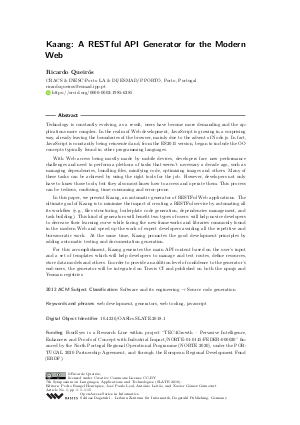Kaang: A RESTful API Generator for the Modern Web
Author
Ricardo Queirós 
-
Part of:
Volume:
7th Symposium on Languages, Applications and Technologies (SLATE 2018)
Part of: Series: Open Access Series in Informatics (OASIcs)
Part of: Conference: Symposium on Languages, Applications and Technologies (SLATE) - License:
 Creative Commons Attribution 3.0 Unported license
Creative Commons Attribution 3.0 Unported license
- Publication Date: 2018-07-13
File

PDF
OASIcs.SLATE.2018.1.pdf
- Filesize: 0.5 MB
- 15 pages
Document Identifiers
Subject Classification
ACM Subject Classification
- Software and its engineering → Source code generation
Keywords
- web development
- generators
- web tooling
- javascript
Metrics
- Access Statistics
-
Total Accesses (updated on a weekly basis)
0PDF Downloads0Metadata Views
Abstract
Technology is constantly evolving, as a result, users have become more demanding and the applications more complex. In the realm of Web development, JavaScript is growing in a surprising way, already leaving the boundaries of the browser, mainly due to the advent of Node.js. In fact, JavaScript is constantly being reinvented and, from the ES2015 version, began to include the OO concepts typically found in other programming languages. With Web access being mostly made by mobile devices, developers face now performance challenges and need to perform a plethora of tasks that weren't necessary a decade ago, such as managing dependencies, bundling files, minifying code, optimizing images and others. Many of these tasks can be achieved by using the right tools for the job. However, developers not only have to know those tools, but they also must know how to access and operate them. This process can be tedious, confusing, time-consuming and error-prone. In this paper, we present Kaang, an automatic generator of RESTFul Web applications. The ultimate goal of Kaang is to minimize the impact of creating a RESTFul service by automating all its workflow (e.g., files structuring, boilerplate code generation, dependencies management, and task building). This kind of generators will benefit two types of users: will help novice developers to decrease their learning curve while facing the new frameworks and libraries commonly found in the modern Web and speed up the work of expert developers avoiding all the repetitive and bureaucratic work. At the same time, Kaang promotes the good development principles by adding automatic testing and documentation generation. For this accomplishment, Kaang generates the main API content based on the user's input and a set of templates which will help developers to manage and test routes, define resources, store data models and others. In order to provide an addition level of confidence to the generator's end-users, the generator will be integrated on Travis CI and published on both the npmjs and Yeoman registries.
Cite As Get BibTex
Ricardo Queirós. Kaang: A RESTful API Generator for the Modern Web. In 7th Symposium on Languages, Applications and Technologies (SLATE 2018). Open Access Series in Informatics (OASIcs), Volume 62, pp. 1:1-1:15, Schloss Dagstuhl – Leibniz-Zentrum für Informatik (2018)
https://doi.org/10.4230/OASIcs.SLATE.2018.1
BibTex
@InProceedings{queiros:OASIcs.SLATE.2018.1,
author = {Queir\'{o}s, Ricardo},
title = {{Kaang: A RESTful API Generator for the Modern Web}},
booktitle = {7th Symposium on Languages, Applications and Technologies (SLATE 2018)},
pages = {1:1--1:15},
series = {Open Access Series in Informatics (OASIcs)},
ISBN = {978-3-95977-072-9},
ISSN = {2190-6807},
year = {2018},
volume = {62},
editor = {Henriques, Pedro Rangel and Leal, Jos\'{e} Paulo and Leit\~{a}o, Ant\'{o}nio Menezes and Guinovart, Xavier G\'{o}mez},
publisher = {Schloss Dagstuhl -- Leibniz-Zentrum f{\"u}r Informatik},
address = {Dagstuhl, Germany},
URL = {https://drops.dagstuhl.de/entities/document/10.4230/OASIcs.SLATE.2018.1},
URN = {urn:nbn:de:0030-drops-92592},
doi = {10.4230/OASIcs.SLATE.2018.1},
annote = {Keywords: web development, generators, web tooling, javascript}
}
Author Details
Funding
FourEyes is a Research Line within project "TEC4Growth – Pervasive Intelligence, Enhancers and Proofs of Concept with Industrial Impact/NORTE-01-0145-FEDER-000020" financed by the North Portugal Regional Operational Programme (NORTE 2020), under the PORTUGAL 2020 Partnership Agreement, and through the European Regional Development Fund (ERDF).
References
-
Stefan Baumgartner. Front-End Tooling with Gulp, Bower, and Yeoman. Manning Publications, 2017.

-
Marijn Haverbeke. Eloquent JavaScript. No Starch Press, 2017.

- Ricardo Queirós. CSS preprocessing: Tools and automation techniques. Information, 9(1), 2018. URL: http://dx.doi.org/10.3390/info9010017.
-
Alex Rauschmayer. Speaking JavaScript: An In-Depth Guide for Programmers. O'Reilly, 2017.

